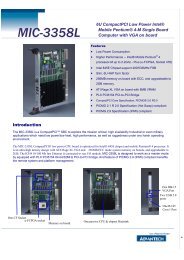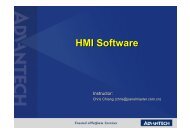industrial wireless book special edition - Networking ...
industrial wireless book special edition - Networking ...
industrial wireless book special edition - Networking ...
You also want an ePaper? Increase the reach of your titles
YUMPU automatically turns print PDFs into web optimized ePapers that Google loves.
IEEE 802.11p MAC protocol for vehicle ad-hoc networks – VANETs<br />
Vehicular Ad-hoc Networks (VANETs) have emerged as a key underlying technology in the realisation<br />
of Intelligent Transportation Systems (ITS). Vehicle communications can greatly reduce the incidence<br />
of accidents. One application is the Intelligent Transportation System (ITS) that includes automatic<br />
control services for improving safety, reducing traffic congestion and increasing passenger comfort.<br />
Although VANETs are particular cases of the general mobile ad-hoc networks, they possess some<br />
characteristics that make its nature exclusive – and present challenges that require a set of new<br />
protocols. Vehicle speeds can be up to 150km/h, while the network topology changes repeatedly<br />
and unpredictably. Hence, the time duration for which a link is active between the vehicles is very<br />
short, e<strong>special</strong>ly when the vehicles are travelling in opposite directions.<br />
One approach to enlarge the lifetime of links is to increase the transmission power, but increase<br />
in a vehicle’s transmission range will result in increasing the probability of data collision and cause<br />
degradation in the overall system throughput. The other solution requires new protocols exhibiting<br />
a very low latency.<br />
The usefulness of the broadcasted messages depends on latency. For example, if a vehicle is<br />
stopping or suddenly stops, it should broadcast a message to warn other vehicles of the probable<br />
danger. Considering that the driver needs at least three quarters of a second to initiate a response,<br />
the warning message should be delivered with virtually no system latency.<br />
Position of nodes changes quickly and unpredictably in VANETs, so that, building an efficient routing<br />
table or a list of neighbour nodes will tire out the <strong>wireless</strong> channel and reduce the network efficiency.<br />
Protocols that rely on prior information about location of nodes are likely to have a bad performance.<br />
However, the topologies of a VANET can be an advantage because the vehicles are not<br />
expected to leave the covered road; therefore, the running direction of vehicles is predictable to<br />
some level. Privacy, safety and security fundamentally affect public acceptance of the technology.<br />
With VANETs, each node corresponds and reports a specific person and location.<br />
Implementation<br />
VANETs involve both vehicle-to-vehicle (V2V) and vehicle-to-infrastructure/roadside (V2I or V2R)<br />
communications that rely on short-to-medium-range communication techniques.<br />
The IEEE-1609 set of standards for Wireless Access in Vehicular Environments (WAVE) specifies an<br />
architecture that includes new standards for vehicle communication aimed at supporting ITS applications.<br />
IEEE-802.11p forms the bottom layers of the WAVE protocol stack and contains MAC and<br />
PHY layers derived from IEEE-802.11a. This makes IEEE-802.11p more suitable for high speed<br />
vehicles. The WAVE protocol forms a LAN to facilitate ITS applications; this LAN defines a WAVE Basic<br />
Service Set (WBSS) comprising vehicle on-board units plus roadside units.<br />
The IEEE-802.11p MAC protocol is derived from the IEEE-802.11 distributed coordination function<br />
(DCF), and also uses the IEEE802.11e EDCA based quality-of-service (QoS) amendments. 802.11<br />
MAC uses CSMA/CA that is specified in almost all variants of IEEE-802.11 (802.11a, 802.11b,<br />
802.11g and 802.11p). RTS (Request-To-Send) and CTS (Clear-To-Send) mechanisms are used to<br />
resolve hidden and exposed node problems (such as found in vehicle movements).<br />
In IEEE-802.11p, both the MAC (medium access control) and the PHY (physical) layers belonging<br />
to the DSRC/WAVE protocols are enhanced. Except for slight parameter changes to enable high user<br />
mobility, the IEEE-802.11p physical layer is identical to IEEE-802.11a. Moreover, the transmission<br />
power may be higher (up to +44dBm) in 802.11p compared to that in 802.11a. IEEE-802.11p MAC<br />
layer is derived from the basic IEEE-802.11 DCF.<br />
The operating frequency for IEEE-802.11p is the 5.85-5.925GHz range in the licensed 5.9GHz ITS<br />
band. For safety applications requiring higher priority, one channel is dedicated to control. Other<br />
channels are service channels that can serve safety and non-safety services.<br />
The function of the MAC is to coordinate the use of the communication medium. MAC layer protocols<br />
decide which node will access the shared medium at any time. As safety critical applications are<br />
designed to alert drivers about immediate danger, therefore requiring tight delay bounds, a MAC<br />
protocol has to take into consideration these strict application requirements.<br />
A study<br />
The focus of a paper 1 on which this box is based is a performance analysis of the IEEE-802.11p<br />
MAC protocol. In the paper, the IEEE-802.11p MAC method was evaluated by developing a VANET<br />
model using MATLAB simulations. The scenario included time-critical packets periodically broadcast<br />
in V2V communications. Channel access delay and the probability of channel access were evaluated.<br />
It was found that when the number of vehicles increased from 100 to 200, channel access delay<br />
increased by around 20ms, and the probability of channel access decreased by about 5%. More<br />
vehicles meant a greater chance of collision, as vehicles have less chance to access the channel.<br />
Moreover, increasing the VANET sensing range from 500 to 1000m reduced channel access probability<br />
by 35%.<br />
The work showed that VANET performs well in small ranges because it becomes easy for vehicles<br />
to communicate with each other. Physical interference and the probability of hidden terminals also<br />
decreased, because in small ranges vehicle location is more likely to be known to other vehicles.<br />
Finally, when simulation times were varied between 50 to 80ms, the probability of vehicles accessing<br />
channels increased by 15%.<br />
1. Performance Evaluation of IEEE 802.11p MAC Protocol for VANETs; Shahzad A. Malik, Madad Ali<br />
Shah, Shahid A.Khan, M.Jahanzeb, Umar Farooq and Adnan Khan. Australian Journal of Basic and<br />
Applied Sciences, 4(8): 4089-4098, 2010.<br />
Transportation<br />
Fig. 2. On Board Units (OBUs) and the Roadside Units (RSUs) were designed for the<br />
demonstrator. These are based on embedded hardware and real-time Linux. The vehicle<br />
OBU communicates with the traffic signal, so drivers know when the next signal change<br />
occurs, allowing time to adjust driving and route accordingly. This can reduce traffic<br />
congestion.<br />
be displayed on the OBU. The OBUs and RSUs transmit beacons at regular<br />
intervals. To avoid placing an unnecessary load on the network, connections<br />
are established only on demand.<br />
Security<br />
The different scenarios call for a reliable and robust communication<br />
platform to ensure that the entire system will be unaffected by local<br />
sponsored by Advantech<br />
<strong>industrial</strong> ethernet <strong>book</strong><br />
disruptions and interference. A security concept must also be developed<br />
to exclude attacks and manipulation. At the forefront are data security,<br />
authentication and data integrity, issues that can be addressed through<br />
encryption, digital signatures and certificates.<br />
The deployment of a public key infrastructure is costly and, as a result,<br />
cannot be efficiently implemented on low-cost hardware. Even so, the<br />
system must guarantee the anonymity of the driver. This can be achieved<br />
by using temporary and revocable pseudonyms.<br />
The advantages<br />
In contrast to car-to-car communication, car-to-roadside communication<br />
delivers advantages as soon as the first vehicle is equipped with<br />
the technology. No minimum penetration rate is called for. The benefits<br />
lie mainly in extra safety, better traffic management and good access<br />
to information and entertainment.<br />
Improved traffic flow – Because the vehicle OBU communicates with<br />
the traffic signal, the driver knows when the next signal change occurs,<br />
allowing him/her to adjust driving and/or route accordingly. This can<br />
reduce traffic congestion.<br />
Increased safety – Vehicle sensors register accidents and their severity.<br />
The vehicle transmits the accident information to the next RSU and a<br />
high-priority emergency call is disseminated throughout the mesh<br />
network. This warns other drivers in the vicinity of the accident, or<br />
forwards the accident report to emergency services control centres, such<br />
as police, fire and rescue services.<br />
More convenience – Service stations supply the RSUs with up-to-date<br />
fuel prices and hours of operation and forward the data to RSUs in their<br />
vicinity. The vehicle can query the data for all service stations located<br />
along the planned route and display the service station with the best<br />
prices on the OBU.<br />
Fraunhofer ESK offers concepts based upon fault-tolerant <strong>wireless</strong><br />
15

















